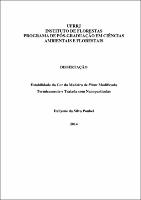| ???jsp.display-item.social.title??? |


|
Please use this identifier to cite or link to this item:
https://tede.ufrrj.br/jspui/handle/jspui/3077| ???metadata.dc.type???: | Dissertação |
| Title: | Estabilidade da cor da madeira de Pinus modificada termicamente e tratada com nanopartículas |
| Other Titles: | Stability of the color of Pinus wood thermally modified and treated with nanoparticles |
| ???metadata.dc.creator???: | Poubel, Dallyene da Silva  |
| ???metadata.dc.contributor.advisor1???: | Garcia, Rosilei Aparecida |
| First advisor-co: | Lelis, Roberto Carlos Costa |
| ???metadata.dc.contributor.referee1???: | Garcia, Rosilei Aparecida |
| ???metadata.dc.contributor.referee2???: | Machado, Gilmara de Oliveira |
| ???metadata.dc.contributor.referee3???: | Abreu, Heber dos Santos |
| ???metadata.dc.description.resumo???: | O objetivo deste trabalho foi avaliar o efeito da modificação térmica e da aplicação de nanopartículas na estabilidade da cor da madeira de Pinus sp após exposição à radiação ultravioleta em condições de envelhecimento acelerado. Amostras de madeira foram tratadas à 180, 200 e 220oC durante 2 horas em um forno mufla Elektro Therm e impregnadas com uma solução aquosa de nanopartículas de óxido de zinco (ZnO) à 1,5% sob pressão e vácuo com o auxílio de um cilindro T10 WTT. O material foi exposto à radiação ultravioleta durante um ciclo total de 168 horas, sendo efetuadas medições de cor à cada 42 horas. As análises colorimétricas foram realizadas com o espectrofotômetro portátil CM 2600d no espaço CIE L*a*b. As propriedades físicas da madeira modificada termicamente também foram determinadas, sendo elas: densidade aparente, teor de umidade de equilíbrio e suas variações após os tratamentos térmicos assim como perda de massa após os tratamentos. A modificação térmica não afetou a densidade da madeira, entretanto, o teor de umidade de equilíbrio foi reduzido significativamente. A modificação térmica causou perda de massa na madeira, cujos valores médios foram de 6,2, 8,6 e 12,8% para as temperaturas de 180, 200 e 220ºC, respectivamente. A modificação térmica causou um escurecimento gradual na madeira com o aumento da temperatura, podendo assim agregar maior valor a madeira de Pinus sp através da criação de novos padrões de cor. A madeira sofreu modificações colorimétricas quando exposta à radiação ultravioleta durante 168 horas. As nanopartículas de ZnO não foram eficientes para a proteção da madeira não modificada termicamente contra a fotodegradação. O tratamento de nanopartículas de ZnO associado à temperatura de 220oC favoreceu a estabilidade da cor da madeira de Pinus. |
| Abstract: | The objective of this study was to evaluate the effect of the thermal modification and application of nanoparticles on the color stability of the Pinus sp wood after exposure to ultraviolet radiation in accelerated aging conditions. Wood samples were heat-treated at 180, 200 and 220oC for two hours in a laboratorial electric muffle from Elektro Therm and impregnated with a solution of 1.5% zinc oxide (ZnO) nanoparticles under pressure and vacuum with a T10 WTT cilinder. The material was exposed to ultraviolet radiation during a total cycle of 168 hours, and color measurements were taken each 42 hours. Colour measurements were realized by using the portable spectrophotometer CM 2600d on the CIE L*a*b* space. The physical properties of the heat-treated wood were also determined: density, equilibrium moisture content and their variations after heat treatments and mass loss following treatments. The thermal modification did not affect the wood density, however, heat treatments reduced significantly the equilibrium moisture content. Thermal modification caused mass loss, with average values of 6.2, 8.6 and 12.8% at temperatures of 180, 200 e 220ºC, respectively. Thermal modification caused a gradual darkening on the wood with the increase of the temperature, this could provide greater value to Pinus sp wood by the creation of new color patterns. The wood presented color changes when exposed to ultraviolet radiation during 186 hours. ZnO nanoparticles were not efficient to protect the thermally untreated wood against photodegradation. The ZnO nanoparticles treatment associated to temperature of 220oC was favorable to the stability of the Pinus wood color. |
| Keywords: | fotodegradação nanotecnologia óxido de zinco photodegradation nanotechnology zinc oxide |
| ???metadata.dc.subject.cnpq???: | Recursos Florestais e Engenharia Florestal |
| Language: | por |
| ???metadata.dc.publisher.country???: | Brasil |
| Publisher: | Universidade Federal Rural do Rio de Janeiro |
| ???metadata.dc.publisher.initials???: | UFRRJ |
| ???metadata.dc.publisher.department???: | Instituto de Florestas |
| ???metadata.dc.publisher.program???: | Programa de Pós-Graduação em Ciências Ambientais e Florestais |
| Citation: | POUBEL, Dallyene da Silva. Estabilidade da cor da madeira de Pinus modificada termicamente e tratada com nanopartículas. 2014. 66 f. Dissertação (Mestrado em Ciências Ambientais e Florestais). Instituto de Florestas, Universidade Federal Rural do Rio de Janeiro, Seropédica, RJ, 2014. |
| ???metadata.dc.rights???: | Acesso Aberto |
| URI: | https://tede.ufrrj.br/jspui/handle/jspui/3077 |
| Issue Date: | 30-Apr-2014 |
| Appears in Collections: | Mestrado em Ciências Ambientais e Florestais |
Files in This Item:
| File | Description | Size | Format | |
|---|---|---|---|---|
| 2014 - Dallyene da Silva Poubel.pdf | Documento principal | 2.72 MB | Adobe PDF |  Download/Open Preview |
Items in DSpace are protected by copyright, with all rights reserved, unless otherwise indicated.




